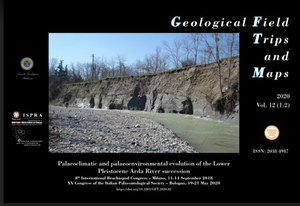Palaeoclimatic and palaeoenvironmental evolution of the Lower Pleistocene Arda River succession
8th International Brachiopod Congress – Milano, 11-14 September 2018. XX Congress of the Italian Palaeontological Society – Bologna, 19-21 May 2020
The Arda River marine succession, cropping out in western Emilia (northern Italy) represents an excellent site to study past ecosystems dynamics in the frame of Early Pleistocene climate change and tectonic activity. This one-day excursion leads the participants to discover the palaeoclimatic and palaeoenvironmental evolution of the Lower Pleistocene Arda River marine section, unraveled through an integrated use of sedimentological, palaeoecological (molluscs and trace fossils) and geochemical tools. Upsection, the succession was deposited in progressively shallower water and colder climate during phases of advance of fan deltas affected by hyperpycnal flows. It culminates at the top with clast supported alluvial conglomerates and freshwater/terrestrial biota indicating a sea level drop and the establishment of a continental environment. It is very rich in fossils: in the marine part molluscs, brachiopods, corals and echinoderms, besides well preserved trace fossils, are abundant; whereas in the continental part a mammal fauna and freshwater/terrestrial molluscs are occasionally found. Sclerochemical analyses undertaken on bivalve shells indicate that seawater temperature seasonality was the main variable of climate change within the study area during the Early Pleistocene. In particular, strong seasonality and low winter palaeotemperatures were assumed to be the main drivers for the widespread establishment of Arctica islandica populations in the palaeo-Adriatic Sea around 1.80 Ma. During the excursion not only fossils are shown, but also interesting biocalcarenitic bodies with a complex geometry cropping out in the town of Castell'Arquato. The excursion is complemented by the visit to the Giuseppe Cortesi geological and palaeontological museum, housing vertebrate and invertebrate fossil collections.
DOI: 10.3301/GFT.2020.02

